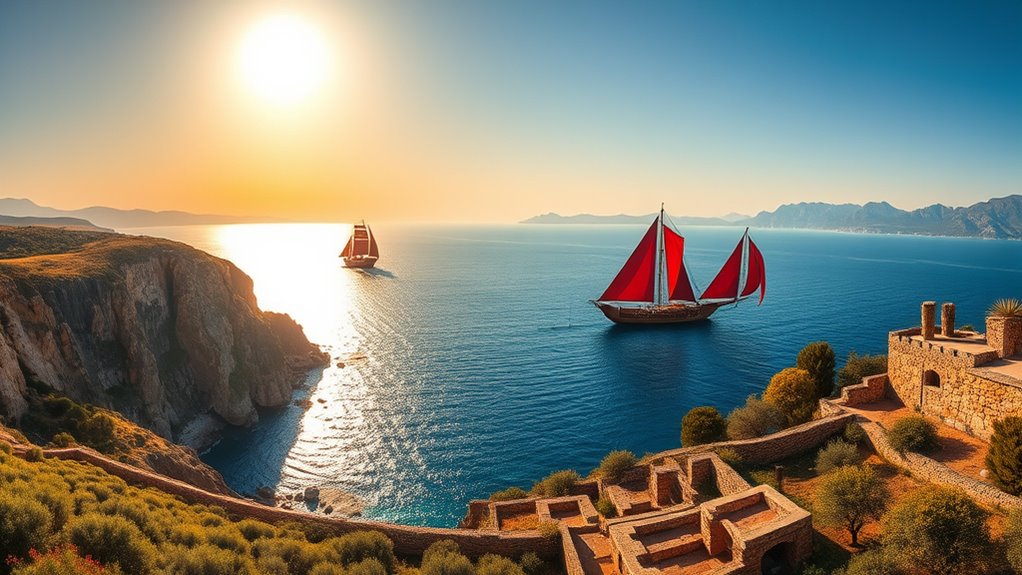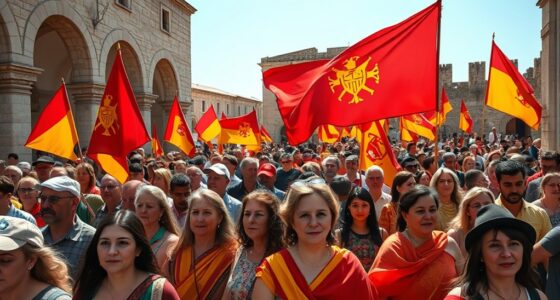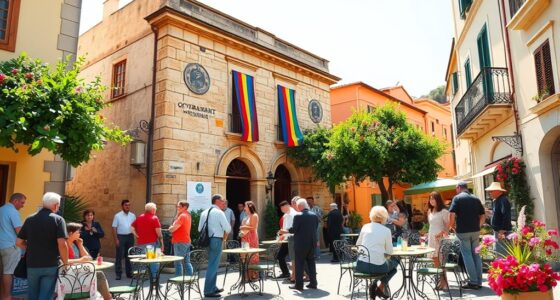Sardinia played a vital role in the Phoenician trade routes by serving as a strategic maritime hub connecting the eastern Mediterranean with western Europe and North Africa. Its natural harbors and resource-rich interior allowed for efficient exchange of goods like metals, timber, and luxury items. The island’s ports facilitated resupply and transshipment, boosting trade and naval power. Exploring further reveals how Sardinia’s position shaped ancient commerce and cultural interactions across the Mediterranean.
Key Takeaways
- Sardinia served as a strategic maritime hub connecting eastern and western Mediterranean trade routes.
- Its ports facilitated cargo transfer, resupply, and piracy protection, supporting Phoenician maritime commerce.
- The island supplied vital resources like metals, timber, and purple dye, fueling regional and long-distance trade.
- Advanced shipbuilding and navigation techniques enabled Phoenicians to conduct open-sea voyages from Sardinian ports.
- Sardinia’s geographic position made it a key transshipment point for luxury goods, minerals, and agricultural products across the Mediterranean.
Early Phoenician Encounters With Sardinia

The earliest Phoenician contacts with Sardinia began in the 9th and 8th centuries BC, primarily along the island’s southern and western coasts. You’d notice that these early interactions mainly involved Nuragic coastal villages, which acted as small markets exchanging diverse goods. As trade grew, more Phoenician families fleeing Lebanon settled in Sardinia, helping to expand these coastal communities into urban centers resembling Phoenician city-states from Lebanon. These settlements in places like Karalis, Nora, and Sulki became important trading hubs, blending Phoenician culture with local traditions through mixed marriages and cultural exchanges. The initial contact wasn’t just about trade but also about establishing a foothold, introducing new technologies, and fostering peaceful coexistence that laid the groundwork for deeper regional integration. Additionally, the development of early urbanization in these settlements reflected the increasing complexity of Phoenician influence on the island.
Sardinia’s Geostrategic Significance in the Mediterranean

You can’t overlook Sardinia’s crucial position in the Mediterranean, sitting centrally between the Italian Peninsula, Corsica, and North Africa. Its location controls key sea routes that link Europe and Africa, making it a essential maritime hub. This strategic coastal placement not only supported Phoenician trade but also shaped regional power dynamics across the basin. Additionally, Sardinia’s natural harbors and rocky coastlines provided safe anchorages for ships navigating the busy trade corridors.
Central Mediterranean Hub
Situated at the heart of the central Mediterranean, Sardinia’s strategic position makes it a pivotal crossroads for maritime trade and military navigation. You can see how its proximity—just 16.45 km south of Corsica—places it between mainland Europe and North Africa, controlling essential passages like the Strait of Bonifacio. Its rugged terrain and natural harbors made it ideal for defense and serving as a stopover for Phoenician ships. Historically, Sardinia connected traders from the eastern Mediterranean with western markets, acting as a transshipment point for metals, textiles, and foodstuffs. Its geographical features supported settlements and resource extraction, reinforcing its role as a hub for communication and cultural exchange among Phoenicians, Greeks, and indigenous peoples. Sardinia’s central location made it indispensable in Mediterranean maritime networks. The island’s rugged mountains and natural harbors further enhanced its strategic importance by providing defensible positions and sheltered anchorage points for ships. Additionally, its geostrategic significance was recognized by various civilizations that sought to control trade routes and expand their influence across the Mediterranean.
Maritime Trade Routes
Thanks to Sardinia’s central position in the Mediterranean, it became a pivotal link in Phoenician maritime trade networks. Its location allowed safe navigation between the Levant, North Africa, and Iberia, making it a essential stopover. Sardinian ports enabled ships to resupply, rest, and transfer cargo, connecting western trade routes to key inland resources. The island’s sheltered bays and natural harbors provided secure anchorage, protecting vessels from piracy and rough seas. These features helped the Phoenicians maintain efficient, long-distance trade operations. Additionally, Sardinia’s proximity to resource-rich inland areas made it a strategic hub for controlling metal supplies and monitoring maritime traffic. This central position strengthened Phoenician influence across the Mediterranean and supported their expanding economic and naval power. Sardinia’s strategic location also allowed for the monitoring of maritime traffic and the protection of trade routes from potential threats, further solidifying its importance in Mediterranean commerce. Moreover, the island’s geostrategic significance contributed to its enduring role as a vital nexus in ancient maritime networks.
Strategic Coastal Locations
Sardinia’s strategic coastal locations elevated its importance as a key maritime hub in the Mediterranean. Positioned centrally in the Western Mediterranean, it connects the Italian and Iberian Peninsulas with North Africa, controlling essential trade routes. Its proximity to key choke points allowed for monitoring and influence over sea traffic, while its southern and western coasts offered natural harbors ideal for settlement and trade. Early Phoenician settlements like Nora and Bithia transformed into thriving centers, fostering cultural exchanges and economic activities. These coastal sites supported industries, exploited local resources, and served as bases for control over trade routes. Their strategic placement enabled naval operations, protected commerce, and established Sardinia as a vital link in Phoenician expansion across the Mediterranean. Archaeological findings confirm the presence of Phoenician artifacts and infrastructure, further emphasizing Sardinia’s role in ancient maritime networks, with maritime infrastructure playing a crucial role in sustaining long-distance trade.
Trade Commodities and Routes Facilitated by Sardinian Ports

Sardinian ports served as essential hubs in Phoenician trade, facilitating the movement of a wide range of commodities across the Mediterranean. You’d find major exports like silver from Spain, timber such as cedar and pine, and purple-dyed cloths and linens, often transshipped through Sardinia. Wine and salted fish also circulated from Phoenician ports on the island. Imported goods included ivory, amber, spices, and precious metals, arriving via Sardinia en route to Phoenician markets. The island’s strategic location connected eastern and western trade routes, serving as a key stopover for goods from Spain, North Africa, and beyond. These routes enabled the exchange of: metals like silver and copper, luxury items like glassware and textiles, agricultural products such as olives and wine, and sophisticated navigational techniques that allowed ships to traverse open waters confidently and efficiently.
Cultural Exchanges and Urban Development in Coastal Towns
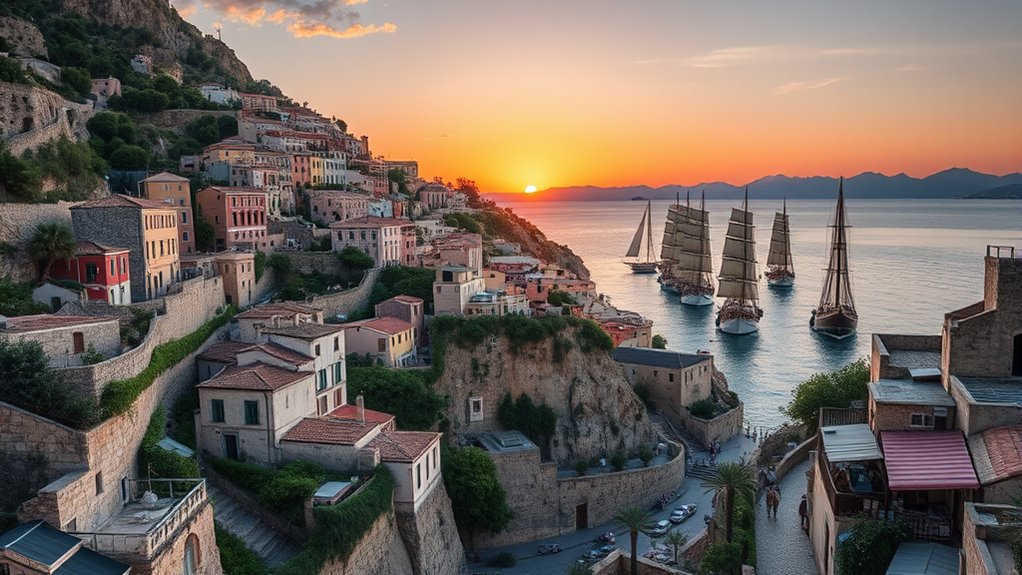
As you explore Sardinia’s coastal towns, you’ll see how their growth reflects a mix of local and Phoenician influences. Religious practices, architecture, and technology merged, creating unique cultural identities and advanced urban layouts. These towns became vibrant centers of trade and cultural exchange, shaping Sardinia’s role in the Mediterranean network. Archaeological findings have revealed Phoenician artifacts in several coastal sites, underscoring their long-standing presence and impact on local development. The self-watering plant pots and other innovative techniques introduced by the Phoenicians likely contributed to the sustainability of urban environments in these regions.
Coastal Urban Growth
Coastal towns along Sardinia transformed rapidly as Phoenician traders established their presence, turning small markets into vibrant urban centers. You notice cities like Tharros, Nora, and Bithia emerging as key trade hubs by the 8th century BC. These urban centers, often on peninsulas or near estuaries, became strategic, defensible, and bustling with activity. The growth was driven by:
- Importing administrative, architectural, and urban planning practices
- Facilitating trade in metals like lead and zinc from Iglesiente
- Supporting demographic expansion through refugee flows from the Levant
This urbanization fostered strong connections between Phoenician settlers and Nuragic populations, blending traditions and fueling economic and cultural development. The cities evolved into complex, interconnected centers that shaped Sardinia’s role in Mediterranean trade networks. Recognizing the significance of urban development in this process highlights how strategic placement and infrastructure contributed to the growth of these cities.
Religious and Cultural Fusion
Religious and cultural fusion in Sardinian coastal towns emerged through active exchanges between Nuragic and Phoenician communities, shaping their spiritual and architectural landscapes. You see this blend in artifacts like Nuragic relics with Phoenician symbols, such as crescent moons and the goddess Tanit. Bronze statuettes combine geometric Nuragic patterns with Phoenician iconography, highlighting artistic collaboration. Phoenician shrines contain Nuragic-style offerings like miniature bronze boats, showing reciprocal exchange. You also notice architectural fusion: Nuragic wells with Phoenician carvings and temples built from local basalt with Middle Eastern designs. Urban layouts mix Nuragic circular huts with Phoenician rectangular buildings, reflecting combined religious and civic planning. The table below evokes the emotional impact of these cultural bonds:
| Cultural Element | Example |
|---|---|
| Religious Symbols | Crescent moons, Tanit |
| Architectural Styles | Nuragic wells, Phoenician temples |
| Urban Layouts | Mixed Nuragic and Phoenician structures |
This cultural blending strengthened trade and cultural ties between the two civilizations, fostering deeper interactions and mutual influence.
Maritime Technological Advances
Maritime technological advances played a pivotal role in establishing Sardinia as a key hub in Phoenician trade networks. These innovations, such as the keeled hull, improved ship stability and open-sea navigation, making long-distance voyages possible. Your navigation skills utilized multiple Mediterranean routes, especially through the Tyrrhenian Sea, ensuring access to Sardinian ports. Phoenician ships, capable of handling transit trade efficiently, transported goods like metals and manufactured items across regions. The island’s strategic position provided ideal stopovers for resupply, thanks to advanced maritime tech. This led to development of Sardinian ports as essential trade centers. Moreover, the Phoenicians’ mastery of maritime technology allowed them to establish reliable communication and supply lines between their colonies and mainland city-states. Construction of docks and shipyards to support maritime activity, and establishment of coastal towns as hub for commerce and cultural exchange. These advances underpinned Sardinia’s prominence in Phoenician trade, facilitated by the navigation techniques that enabled precise and safe passage across vast distances.
Integration of Phoenician Maritime Technologies and Practices

The Phoenicians brought advanced maritime technologies to Sardinia, transforming the island into a pivotal hub in their Mediterranean trade network. You learn how their sailors used stellar navigation and coastal landmarks, including Sardinia, to find precise routes and safe harbors like Sulci and Karalis. Their sturdy ships, capable of oceanic voyages, were built with techniques transferred from the Levant, supporting long-distance trade. Sardinian ports such as Sant’Imbenia showcase Phoenician harbor engineering, reflecting their maritime expertise. Artisans adopted Phoenician shipbuilding methods and metallurgical techniques, boosting local production. The use of amphorae and pottery in trade was influenced by Phoenician styles, with isotopic analysis linking Sardinian ores to metallic exchanges. These technological and practical integrations made Sardinia a essential link in Phoenician maritime commerce. Moreover, the Phoenicians introduced innovative shipbuilding techniques and navigational tools that improved the durability and efficiency of their vessels, further enhancing Sardinia’s strategic importance. Their mastery of stellar navigation played a crucial role in establishing reliable trade routes across the Mediterranean, reinforcing Sardinia’s position as a key maritime connector.
Transition From Phoenician to Carthaginian Domination
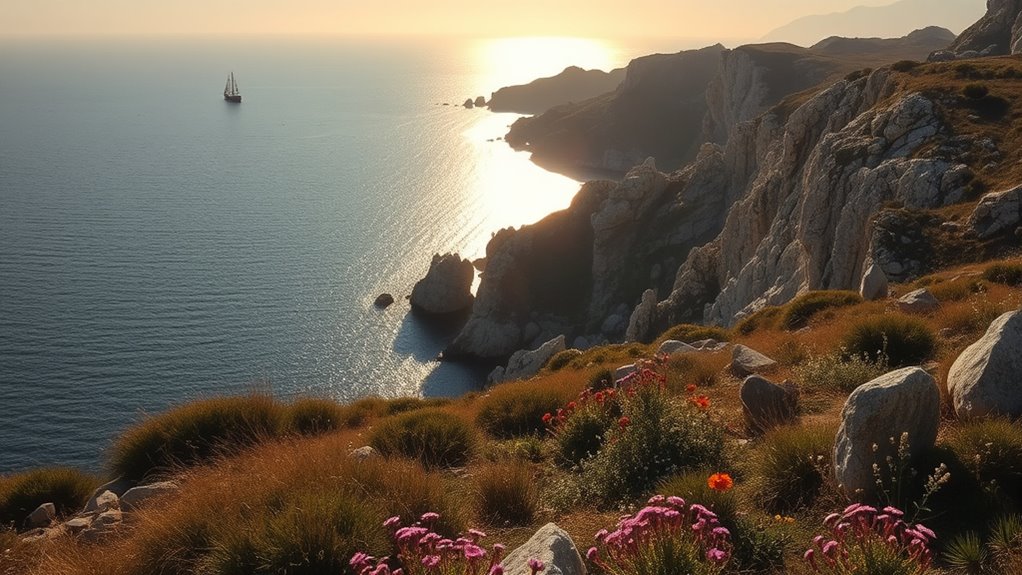
As Phoenician power waned in the Mediterranean, Carthage launched military campaigns to take control of Sardinia, conquering key coastal cities like Karalis and Nora. You see, Hamilcar and Hasdrubal led the campaigns that effectively brought much of the island under Carthaginian rule. The indigenous Nuragic population resisted, retreating to the mountainous interior, creating a cultural divide. Carthaginian governance replaced Phoenician-Nuragic cooperation, establishing centralized authorities in coastal cities. The campaigns were supported by maritime control and alliances with local groups, which helped secure Carthage’s dominance over the island. Coastal cities like Karalis and Nora became Punic strongholds. The Nuragic interior maintained a degree of independence. Military fortifications and a fortified border system limited Nuragic movements. Despite these measures, trade persisted across the frontier, and Sardinia’s strategic importance grew as Carthage solidified its dominance.
Sardinia as a Hub for Metal Resources and Resource Exploitation
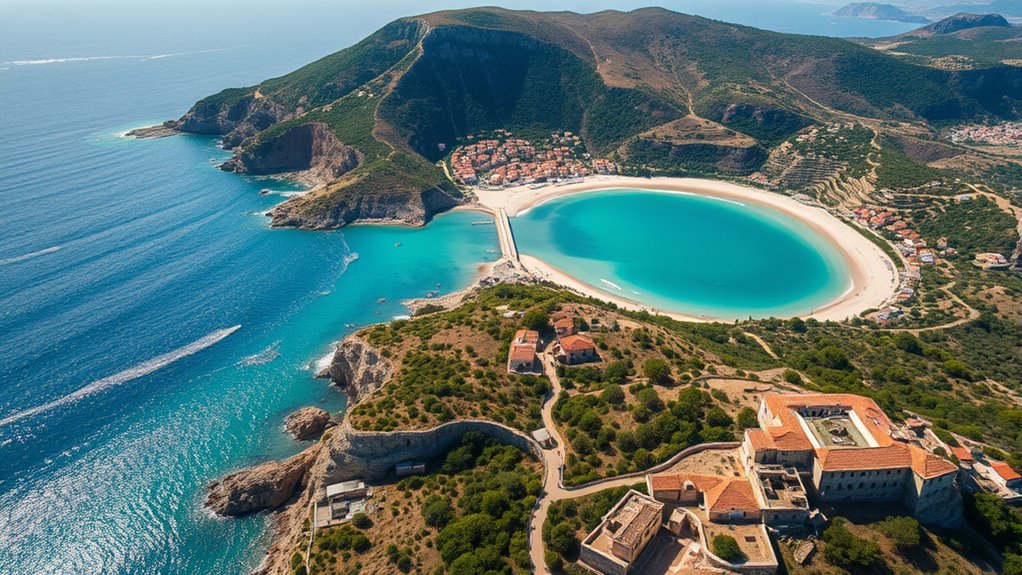
You can see how Sardinia’s rich metal mines, especially for silver and lead, made it a essential resource hub for the Phoenicians. They controlled key trade routes and used strategic ports to manage extraction and export, often working alongside local Nuragic communities. This resource exploitation helped establish Sardinia as a critical link in Mediterranean metallurgy and trade networks. The island’s strategic position also facilitated the development of maritime connectivity between different regions of the Mediterranean, further enhancing its importance in trade.
Sardinian Metal Mines
Sardinia’s rich geological makeup has made it a crucial hub for metal resource exploitation since ancient times. The island’s abundant deposits of copper, lead, zinc, and iron oxides fueled extensive mining activities, especially in regions like Iglesiente and Sarrabus. Phoenicians played a key role in developing these mines between the 10th and 8th centuries BCE, employing advanced smelting and processing techniques. Evidence of their work includes archaeological finds such as slag and artifacts at sites like Montevecchio and Sa Frangia. The metals extracted supported trade across the Mediterranean, fostering cultural and economic exchanges.
- Rich mineral deposits supporting long-term mining
- Advanced Phoenician smelting and refining practices
- Key trade routes enhancing resource exchange
Silver Trade Significance
Did you know that Sardinia served as a essential maritime hub for the ancient Phoenicians seeking silver? Long before they settled there, Sardinia supplied silver to the Levant, showing early long-distance trade. Lead isotope analysis confirms it was a key source during the 10th and 9th centuries BCE, supporting Phoenician westward expansion. The island’s abundant silver resources made it a pivotal node for metal supply, facilitating trade routes toward Iberia and beyond. Sardinia functioned as a staging point, allowing Phoenicians to access silver and tin reserves further west. Their activities introduced advanced silver processing techniques to Europe, boosting local economies. The pursuit of silver motivated Phoenician exploration and commerce, fueling the establishment of coastal trading posts and enabling control over western Mediterranean trade networks. Sardinia’s rich mineral deposits also attracted early interest from other ancient civilizations, emphasizing its strategic importance in regional resource exploitation.
Resource Control Strategies
How did the Phoenicians strategically control and exploit metal resources in Sardinia? They targeted key regions, especially in the southwest, for their rich copper and lead deposits, using their maritime advantage to oversee and manage extraction. They established settlements near mining areas, likely overseeing or partnering in production. To maximize resource control, they employed techniques like lead smelting and cupellation, expanding local metallurgical skills. Their strategies included: developing trade routes that facilitated the movement of raw materials, establishing settlement patterns near key mining zones, and integrating local populations into their resource management systems. This approach allowed the Phoenicians to dominate Sardinian metal resources, ensuring a steady supply for their trade networks. Sardinia became a vital node, linking western Mediterranean resources with markets in the Levant and beyond, boosting their economic and political leverage.
Impact of Phoenician Trade on Sardinian Society and Economy

The introduction of Phoenician trade considerably transformed Sardinian society and economy by fostering new economic practices and social structures. You’d notice increased economic activity, marked by new ceramic forms like Sant’Imbenia amphorae, blending local and Near Eastern techniques for export and transport. This boosted market expansion within Sardinia and across the Mediterranean, with Sardinian pottery found in distant colonies. Coastal trading posts and ports turned Sardinia into a crucial hub, facilitating access to mineral resources like lead and silver, and attracting Carthaginians. Societally, Phoenician contact introduced hybrid crafts, altered social hierarchies, and shifted settlements from clans to organized urban centers. The spread of Phoenician technology and writing system further enhanced trade efficiency, fostering a more interconnected and prosperous Sardinian society. The Phoenicians established numerous colonies and trading outposts along Sardinia’s coast, which played a pivotal role in integrating the island into broader Mediterranean trade networks.
Archaeological Evidence of Phoenician Presence and Trade Goods
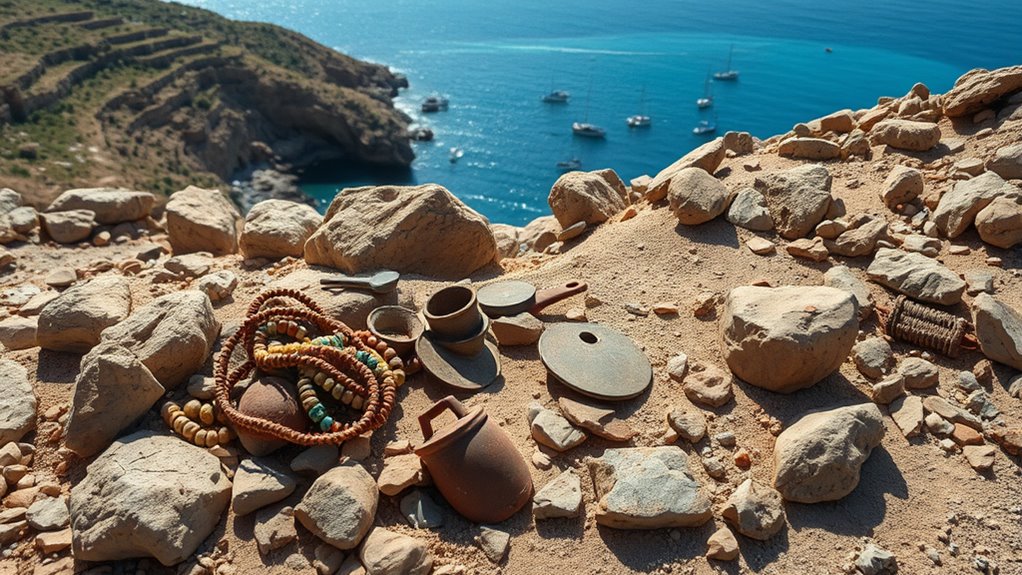
Archaeological discoveries across Sardinia provide compelling evidence of Phoenician presence and extensive trade networks. You find imported luxury goods like jewelry and finely crafted ceramics, showing Sardinia’s role in Phoenician commerce. Religious artifacts, such as goddess Astarte statues, highlight the import of cult objects and religious practices. Phoenician inscriptions, like the inscription on the stone of Nora, reveal literacy, trade documentation, or ownership marks. The distinctive pottery styles, including amphorae and fine wares, demonstrate active trade relations and cultural exchange. Metal objects, such as bronze tools and weapons, indicate metal trade and exploitation of Sardinia’s mineral resources. These artifacts collectively show Sardinia’s integration into Phoenician trade routes and cultural sphere, confirming its strategic importance in the Mediterranean.
The Long-term Influence of Phoenician Maritime Networks in the Mediterranean

Phoenician maritime networks expanded far beyond their homeland, connecting the Eastern Mediterranean with North Africa, Spain, Sicily, and Italy. You’d see colonies and trading posts from the Levantine coast to Carthage, strengthening Phoenician influence across the central and western Mediterranean. Their navigational skills enabled them to circumnavigate Africa around 600 BCE, proving their vast reach. Natural geographic features, like the mountainous Levant coast, made sea routes preferable to overland trade. Access to raw materials such as Lebanese cedar supported the construction of advanced ships, essential for maintaining extensive trade routes. These networks fueled economic prosperity by trading timber, textiles, dyes, and metals, while ports became cultural melting pots. Over centuries, Phoenician maritime influence shaped trade, technology, and cultural exchange, leaving a lasting legacy across the Mediterranean. Their maritime technology and navigation skills also allowed them to establish durable trade routes and colonies that persisted for centuries.
Frequently Asked Questions
How Did Phoenician Settlement Influence Sardinian Indigenous Cultures?
You see that Phoenician settlement greatly influenced Sardinian indigenous cultures through cultural blending, trade, and religion. They introduced new technologies, shaped urban development, and integrated their religious practices with local traditions. Intermarriages led to genetic and cultural exchange, creating a hybrid society. You notice the adoption of Phoenician artifacts, religious cults, and urban layouts, all of which transformed Sardinia into a vibrant, interconnected part of the Mediterranean world.
What Specific Technologies Did Phoenicians Introduce to Sardinian Shipbuilding?
Imagine you’re examining Phoenician shipbuilding, and you notice their pegged mortise-and-tenon joinery, which made hulls sturdier. They introduced this technique to Sardinian craftsmen, enhancing vessel durability. You see how ribs inside the hull reinforce structure, and the keeled hull improves stability. These innovations, combined with advanced rigging and steering systems, allowed Sardinian ships to undertake long-distance voyages, boosting trade and navigation across the Mediterranean.
How Did Sardinia’s Natural Resources Impact Phoenician Trade Profits?
Your focus on Sardinia’s natural resources shows how they boosted Phoenician trade profits. With access to valuable metals like silver, lead, and iron, you helped produce weapons, tools, and currency, increasing trade value. The island’s resources allowed you to control key raw materials, reduce reliance on eastern sources, and create luxury goods. This strategic advantage expanded your trade networks, increased wealth, and strengthened Phoenician economic influence across the Mediterranean.
In What Ways Did Phoenician Religious Practices Integrate Into Sardinian Society?
You might think Phoenician religious practices stayed in their homeland, but they seamlessly integrated into Sardinian society. As you explore, you’ll see how local temples and sacred symbols blended with indigenous beliefs, creating a unique spiritual landscape. Phoenicians brought their gods, rituals, and iconography, which they adopted and adapted, influencing local traditions. This fusion fostered cultural exchange, making Sardinia a vibrant hub of religious diversity rooted in Phoenician practices.
How Did Sardinia’S Role Evolve During the Transition From Phoenician to Carthaginian Control?
During the shift from Phoenician to Carthaginian control, you see Sardinia’s role shift from a collection of small coastal trading hubs to a strategic and essential part of the Mediterranean empire. You notice increased urbanization, fortified ports, and a focus on resource extraction, especially metals. Sardinia becomes a key link, connecting Carthage’s African base and western Mediterranean trade routes, solidifying its importance in regional economic and military power.
Conclusion
So, when you consider Sardinia’s role in the Phoenician trade, it’s like discovering the secret heart of the ancient Mediterranean world. This island wasn’t just a stopover—it was the buzzing, unstoppable engine fueling trade routes that shaped civilizations. Sardinia’s influence was so huge, it’s almost as if it held the entire Mediterranean in its palm, turning the island into the legendary epicenter of commerce, culture, and maritime mastery that still echoes today.
